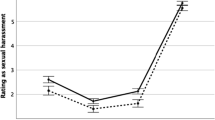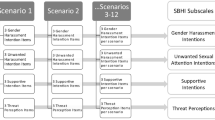Abstract
Two studies were conducted to examine an attributional model of judgments of sexual harassment. The key assumption of the model is that judgments of sexual harassment involve the attribution of negative intentions (e.g., hostility or callousness) to an actor with regard to a sexual behavior. The two studies effectively demonstrated that many factors known to influence the attribution of intentionality play an important role in judgments of sexual harassment. The findings are discussed with regard to understanding how people differ in their judgments of sexual harassment.
Similar content being viewed by others
References
Benson, D. J., & Thomson, G. E. Sexual harassment on a university campus: The confluence of authority relation, sexual interest and gender stratification. Social Problems, 1982, 29, 236–251.
Bower, G. H. Experiments on story comprehension and recall. Discourse Processes, 1978, 1, 211–231.
Guteck, B. A. Sex and the workplace. San Francisco: Jossey-Bass, 1985.
Gutek, B. A., Morasch, B., & Cohen, A. G. Interpreting sexual behavior in a work setting. Journal of Vocational Behavior, 1983, 22, 30–48.
Gutek, B. A., Nakamura, C. Y., Gahart, M. Handschumacher, I., & Russell, D. Sexuality and the workplace. Basic and Applied Social Psychology, 1980, 1, 255–265.
Heider, F. The psychology of interpersonal relations. New York: Wiley, 1958.
Horgan, D. D., & Reeder, G. Sexual harassment: The eye of the beholder. American Association of Occupational Health Nurses Journal, 1986, 34, 83–86.
Jones, E. E., & McGillis, D. Correspondent inferences and the attribution cube: A comparative reappraisal. In J. H. Harvey, W. J. Ickes, & R. F. Kidd (Eds.), New directions in attribution research (Vol. 1). Hillsdale, NJ: Erlbaum Associates, 1976.
Jones, E. E., Davis, K., & Gergen, K. Role play variations and their informational value for person perception. Journal of Abnormal and Social Psychology, 1961, 63, 302–310.
Kelley, H. H. The process of causal attribution. American Psychologist, 1973, 28, 107–128.
Kelley, H. H., & Michela, J. L. Attribution theory and research. Annual Review of Psychology, 1980, 31, 457–501.
McArthur, L. Z. The how and what of why: Some determinants and consequences of causal attributions. Journal of Personality and Social Psychology, 1972, 22, 171–193.
Pryor, J. B. The lay person's understanding of sexual harassment. Sex Roles, 1985, 13, 273–278.
Pryor, J. B. Sexual harassment proclivities in men. Sex Roles, 1987, 17, 269–289.
Quinn, R. E., & Lees, P. L. Attraction and harassment: Dynamics of sexual politics in the workplace. Organizational Dynamics, 1984, 6, 35–46.
Regan, D. T., & Totten, J. Empathy and attribution: Turning observers into actors. Journal of Experimental Social Psychology, 1975, 32, 850–856.
Reilly, T., Carpenter, S., Dull, V., & Bartlett, K. The factorial survey: An approach to defining sexual harassment on campus. Journal of Social Issues, 1982, 38, 99–110.
Somers, A. Sexual harassment in academe: Legal issues and definitions. Journal of Social Issues, 1982, 38, 23–32.
Storms, M. D. Videotape and the attribution process: Reversing actors' and observers' point of view. Journal of Personality and Social Psychology, 1973, 27, 165–175.
United States Merit Systems Protection Board. Sexual harassment in the federal workplace: Is it a problem? Washington, DC.: Government Printing Office, 1981.
Weber-Burden, E., & Rossi, P. H. Defining sexual harassment on campus: A replication and extension. Journal of Social Issues, 1982, 38, 111–120.
Wegner, D. M., & Guiliano, T. The forms of social awareness. In W. J. Ickes & E. S. Knowles (Eds.), Personality, roles and social behavior. New York: Springer-Verlag, 1982.
Author information
Authors and Affiliations
Additional information
The studies described in this article were reported in a presentation at the 1986 meeting of the Midwestern Psychological Association in Chicago.
Rights and permissions
About this article
Cite this article
Pryor, J.B., Day, J.D. Interpretations of sexual harassment: An attributional analysis. Sex Roles 18, 405–417 (1988). https://doi.org/10.1007/BF00288392
Issue Date:
DOI: https://doi.org/10.1007/BF00288392




